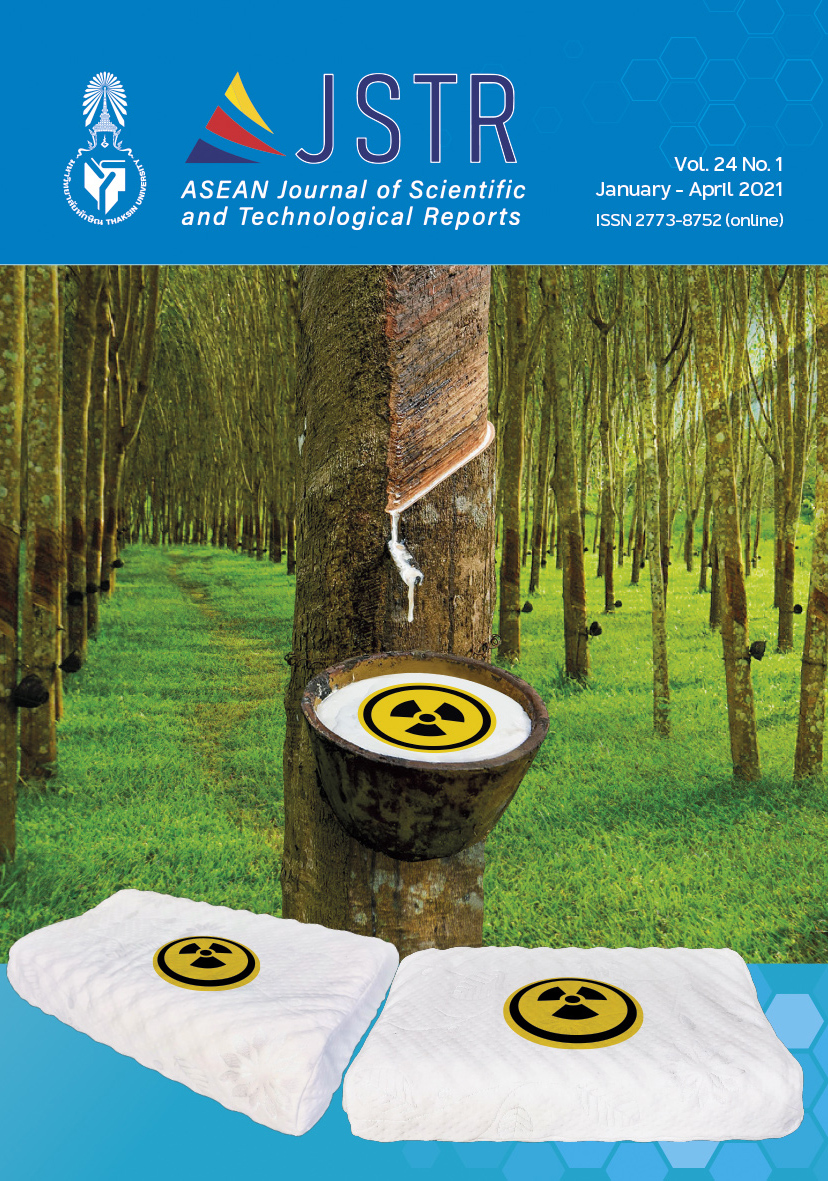Measurement of 222Rn Exhalation Rate from Natural Rubber Latex Pillows Randomed from Online Market in Thailand
Main Article Content
Abstract
Radon is a natural radioactive gas, and it is increasingly interesting worldwide because it affects the human healthy and increases lung cancer risk when people receive high concentrations over extended periods of time by inhalation. The study was to measure the radon concentration, determine the radon exhalation rate, and estimate annual effective dose level in order to set up a policy on controlling the contamination of radon in the natural rubber latex products in Thailand, and the radon concentrations were measured from natural rubber latex pillows randomized from online market in Thailand by closed chamber system technique with ATMOS 12 DPX. The results showed that the equilibrium radon concentrations were ranged between 11 ± 2 and 43 ± 5 Bqm–3 with an average value of 17 ± 9 Bqm–3. All measured radon concentrations were well below the allowed maximum contamination level of radon concentration in collected samples of 148 and 300 Bqm–3, recommended by the USEPA and the ICRP, respectively. The exhalation rates from natural rubber latex pillows were ranged 12 ± 3 and 60 ± 7 mBq m–2 h–1 with an average value of 25.7 ± 14.4 mBq m–2 h–1. The annual effective doses calculated for inhalation were between 0.12 ± 0.03 and 0.43 ± 0.05 mSv y–1, and also well lower than the annual effective dose for general public (1.0 mSv y–1) recommended by the ICRP.
Article Details

This work is licensed under a Creative Commons Attribution-NonCommercial-NoDerivatives 4.0 International License.
References
World Health Organization (WHO). (2009). Handbook on Indoor Radon: A Public Health Perspective. Geneva: WHO Press.
International Commission on Radiological Protection (ICRP). (1993). Protection Against Radon-222 at Home and at Work. ICRP Publication 65. Annuals of the ICRP 23(2). Oxford: Pergamon Press.
Fior, L., Corrêa, J. N., Paschuk, S. A., Denyak, V. V, Schelin, H. R., Soreanu Pecequilo, B. R., & Kappke, J. (2012). Activity measurements of radon from construction materials. AppliedRadiation and Isotopes, 70(7), 1407–1410. DOI:10.1016/j.apradiso.2011. 11.036.
Maged, A. F., Ismail, L. Z., & Moussa, N. L. A. (2012). Environmental risk assessment of radon from ceramic tiles. Radioprotection, 47(3), 403–411. DOI:10.1051/radiopro/ 2012011.
Perna, A. F. N., Paschuk, S. A., Corrêa, J. N., Narloch, D. C., Barreto, R. C., Claro, F. D., & Denyak, V. (2018). Exhalation rate of radon-222 from concrete and cement mortar. Nukleonika, 63(3), 65–72. DOI:10.2478/nuka-2018-0008.
Sarrou, I., & Pashalidis, I. (2017). Radon exhalation from granite countertops and expected indoor radon levels. Journal of Radioanalytical and Nuclear Chemistry, 311(1), 913–916. DOI: 10.1007/s10967-016-5108-7.
Stajic, J. M., & Nikezic, D. (2015). Measurement of radon exhalation rates from some building materials used in Serbian construction. Journal of Radioanalytical and Nuclear Chemistry, 303(3), 1943–1947. DOI:10.1007/s10967-014-3726-5.
Srisuwan, T., Wanabonges, P., & Tantasavasdi, C. (2012). The influence of finishing materials on radon exhalation from concrete with phosphogypsum additives. The Journal of Architectural /Planning Research and Studies, 9(2), 105–112.
Sola, P., Srinuttrakul, W., Laoharojanaphand, S., & Suwankot, N. (2014). Estimation of indoor radon and the annual effective dose from building materials by ionization chamber measurement. Journal of Radioanalytical and Nuclear Chemistry, 302(3), 1531–1535. DOI: 10.1007/s10967-014-3716-7.
Kaewtubtim, P., Sola, P., & Kongpakdee, T. (2019). Radon concentration and radon exhalation rate from rock samples used for construction at northern part of Yala province. Rajamangala University of Technology Krungthep Research Journal, 13(2), 187–197.
The Korea Times. (2018). Tourists exposed to harmful latex in Thailand (Online). Retrieved 20 March 2020, from http://www.koreatimes.co.kr/www/news/nation/2018/06/356_250111. html.
The Korea Bizwire. (2018). Radon Detected in 80% of Latex Products (Online). Retrieved 20 March 2020, from http://koreabizwire.com/radon-detected-in-80-of-latex-products/121374.
Kovler, K. (2007). Measurements of radon exhalation rate for monitoring cement hydration. Materials and Structures, 40(4), 419–430. DOI:10.1617/s11527-006-9149-1.
Hassan, N. M., Hosoda, M., Ishikawa, T., Sorimachi, A., Sahoo, S. K., Tokonami, S., & Fukushi, M. (2009). Radon migration process and its influence factors: review. Japanese Journal of Health Physics, 44(2), 218–231. DOI:10.5453/jhps.44.218.
Krisiuk, E. M. (1980). Airborne radioactivity in buildings. Health Physics, 38(2), 199–202.
Kovler, K., Perevalov, A., Steiner, V., & Metzger, L.A. (2005). Radon exhalation of cementitious materials made with coal fly ash: Part 1 – scientific background and testing of the cement and fly ash emanation. Journal of Environmental Radioactivity, 82(3), 321–334. DOI: 10.1016/j.jenvrad.2005.02.004.
United Nations Scientific Committee on the Effects of Atomic Radiation (UNSCEAR). (2000). Sources and Effects of Ionizing Radiation, Annex B. I. UNSCEAR Report to the United Nations General Assembly. New York: United Nations Publication.
International Commission on Radiological Protection (ICRP). (1991). 1990 Recommendations of the International Commission on Radiological Protection. ICRP Publication 60. Annual of the ICRP 21 (1-3). Oxford: Pergamon Press.
International Commission on Radiological Protection (ICRP).(2007). The 2007 Recommendations of the International Commission on Radiological Protection. ICRP Publication 103. Annual of the ICRP 37 (2–4). Oxford: Elsevier Ltd.
Bala, P., Kumar, V., & Mehra, R. (2017). Measurement of radon exhalation rate in various building materials and soil samples. Journal of Earth System Science, 126(2), 31. DOI: 10.1007/s12040-017-0797-z.
International Commission on Radiological Protection (ICRP). (2014). Radiological Protection against Radon Exposure. ICRP Publication 126. Annual of the ICRP 43(3). London: Sage Publications Ltd.


